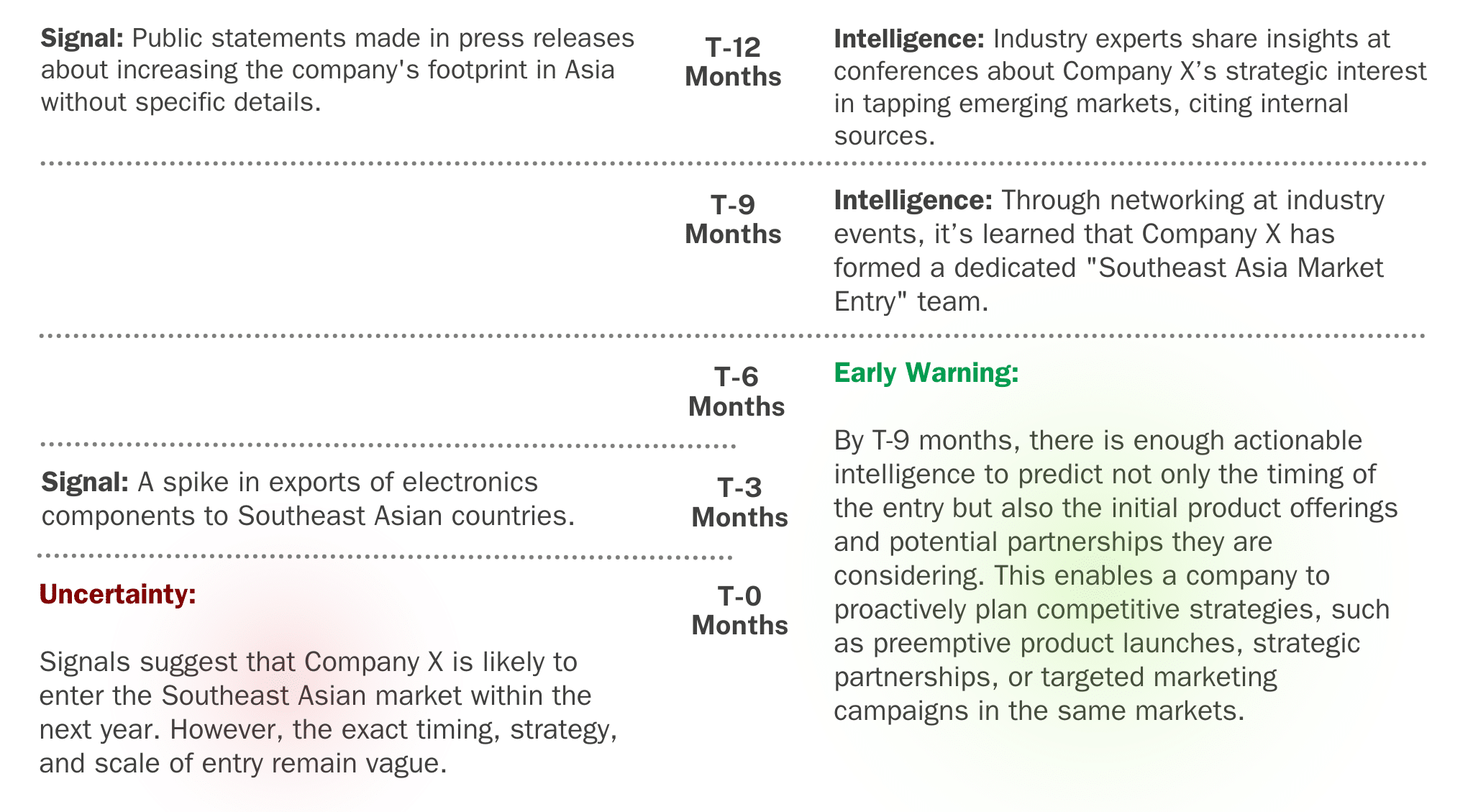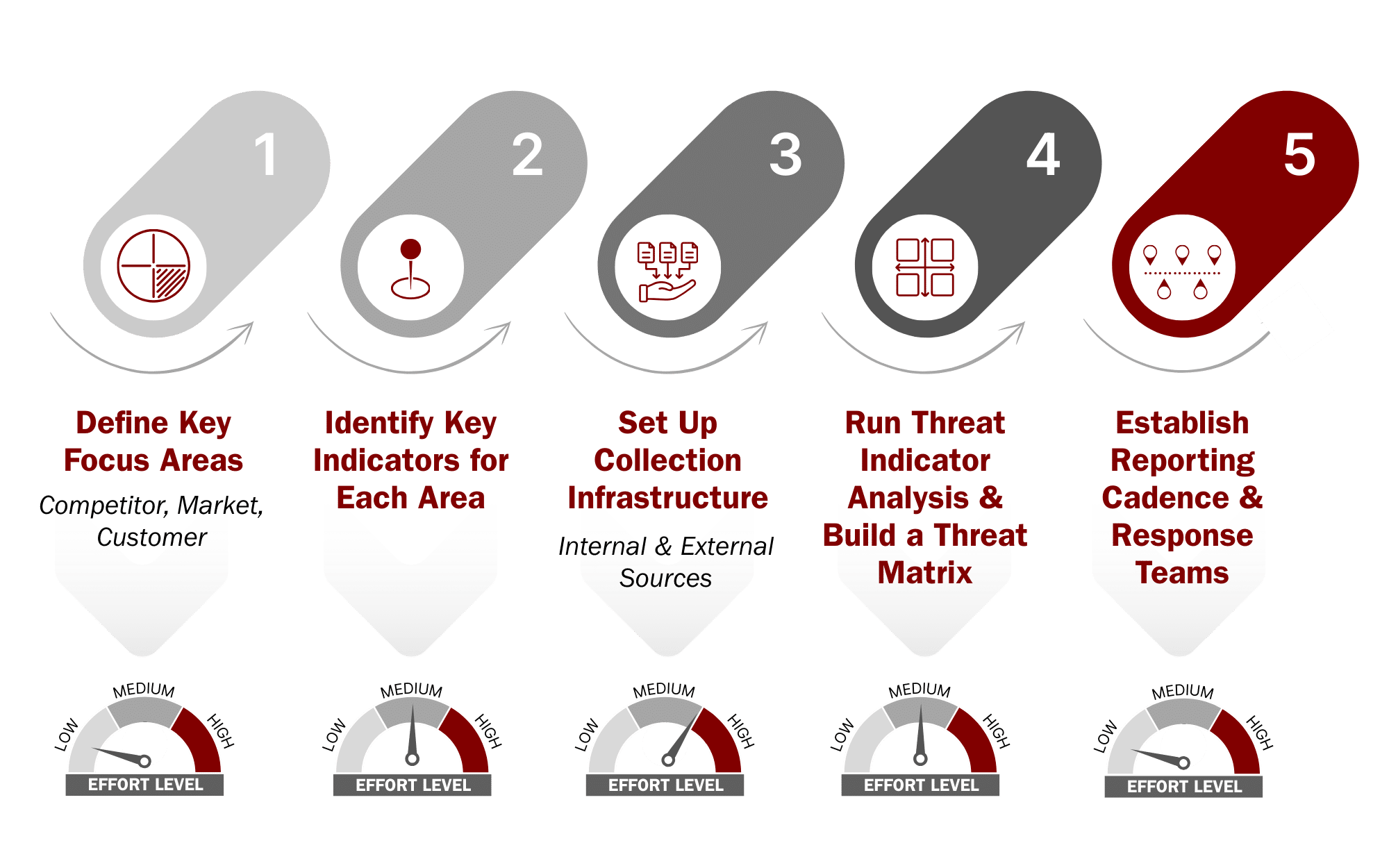Companies that bet big on bold moves; entering new markets, launching disruptive products, shifting strategies, can win big. But the downside is just as dramatic.
What if you could accurately predict competitor moves, market shifts, and changes in customer preferences before they happen? Sound too good to be true? It isn’t, and fortunately, you don’t need a crystal ball to anticipate the future. You just need the right early warning system.
What Is an Early Warning System?
An early warning system (EWS) is a strategic capability designed to identify, monitor, and respond to signals of change within a company’s external environment. It integrates data and intelligence from multiple sources to provide early visibility into potential threats and opportunities.
Core Components of a Traditional EWS:
- Data Feeds: includes secondary (published) intelligence
- Monitoring and Analysis Processes: tools and techniques to detect meaningful signals, trends, and insights to assess their implications
- Outcome-Driven Actions: insight-based decisions that enable timely tactical responses and long-term strategic planning
EWS Powered by Primary Research
The differentiator? Primary research.
When primary research, intelligence sourced directly from individuals, is integrated into an EWS, it transforms the capability from reactive to proactive. It creates a forward-looking, predictive intelligence system which can’t be replicated by competitors.
Why primary research matters
Primary research gathers unique insights not available in published, secondary sources. This includes direct interviews with industry experts, conversations with suppliers, customer surveys, and competitive field research. On its own, primary research provides deep visibility into the intent and direction of competitors, customers, and the market.
But to maximize its power, primary research should be structured within a broader EWS framework where it is continuously collected, analyzed, and acted on.
The Proactive Power of Primary Research
Primary research-based EWS’s provide visibility into what’s going to happen. This enables companies to design proactive strategies that anticipate change instead of reacting to it.
Example: Market Expansion by a Competitor
To illustrate the effectiveness of a primary research-based EWS, let’s consider a hypothetical scenario where a competitor, “Company X,” is planning to expand into a new geographic market. Let’s take a closer look:



While the above example focuses on a competitor’s future action, the same process and differentiation applies to Market and Customer Early Warning as well, where primary research provides the predictive insights needed to support proactive decision making.
Real-World Example: Betting Big, Moving Smart
One Sedulo client—a Global 2000 retail and supply chain company—faced a high-stakes market entry into the EMEA region amid the anticipated removal of U.S. sanctions. By leveraging Sedulo’s primary research capabilities, including its Persistent Source Network™, the company gained forward-looking insights into legal procedures, local partnerships, and strategic positioning. This intelligence not only de-risked their go-to-market strategy but enabled a proactive, well-informed launch.
More Than Just Your Competitors
Competitor early warning
A central component to any EWS is to monitor competitor activity. This could include new product launches, feature updates, changes in pricing and packaging, new partnerships, expanded sales channels, etc. However, gathering predictive intelligence, which is critical to building proactive strategies, requires more than just tracking a competitor’s current activities. A primary research-based EWS framework provides insights into competitors’ strategic intentions and planned activities. This foresight enables companies to develop strategies that preempt competitive moves.
Market early warning
While tracking competitor activity is essential, identification of white space opportunities and emerging threats is critical to stay ahead in the market. Through primary research with industry Subject Matter Experts (SME) and analysts, companies can identify indicators of change before the market shift occurs. This early detection empowers companies to craft strategies that exploit these future shifts for market advantage, positioning them as leaders who shape industry standards.
Customer early warning
Customer preferences and unmet needs can change quickly and unpredictably. Primary interviews, qualitative surveys, and direct observations of customers provide real-time insight into evolving customer sentiments and preferences, uncovering emerging needs before they become mainstream. This proactive engagement helps companies anticipate shifts in customer behavior, enabling them to adjust their strategies to meet changing customer needs and future demands.
Making It Work—Integration and Tools
To increase the organizational impact of an Early Warning System, the insights should be accessible by senior leadership for strategic consideration, as well as by department managers that can leverage the insights for tactical planning. Leveraging analytical tools like Threat Indicator Analysis and a Threat Matrix provides decision makers and planners with the threat and opportunity insights they need to make informed, proactive decisions.
Building Strategic Agility
The core benefit of a primary research-based EWS is agility. In an unpredictable market, speed is a differentiator. The predictive power of primary research enables companies to act fast, plan smart, and lead with confidence. Organizations that can anticipate moves, whether from a rival, a market force, or a customer segment, are better positioned to win.
How to Get Started: Standing Up an EWS
Getting started with an EWS doesn’t require a full-scale transformation on day one. With the right focus, structure, and vendor, organizations can quickly pilot and operationalize a capability that delivers high-value insights across strategy and execution. Here’s a high-level roadmap to launch your EWS:

The entire initiative can be piloted in 8–12 weeks with the right internal alignment or external partner support.
How Sedulo Can Help
A well-executed EWS does more than alert you to what’s coming. It equips you to lead. With primary research as its foundation, your organization can transform insight into action, and uncertainty into opportunity. Contact Sedulo Group today to learn more about how we help clients gain strategic foresight through a primary research driven Early Warning System.

